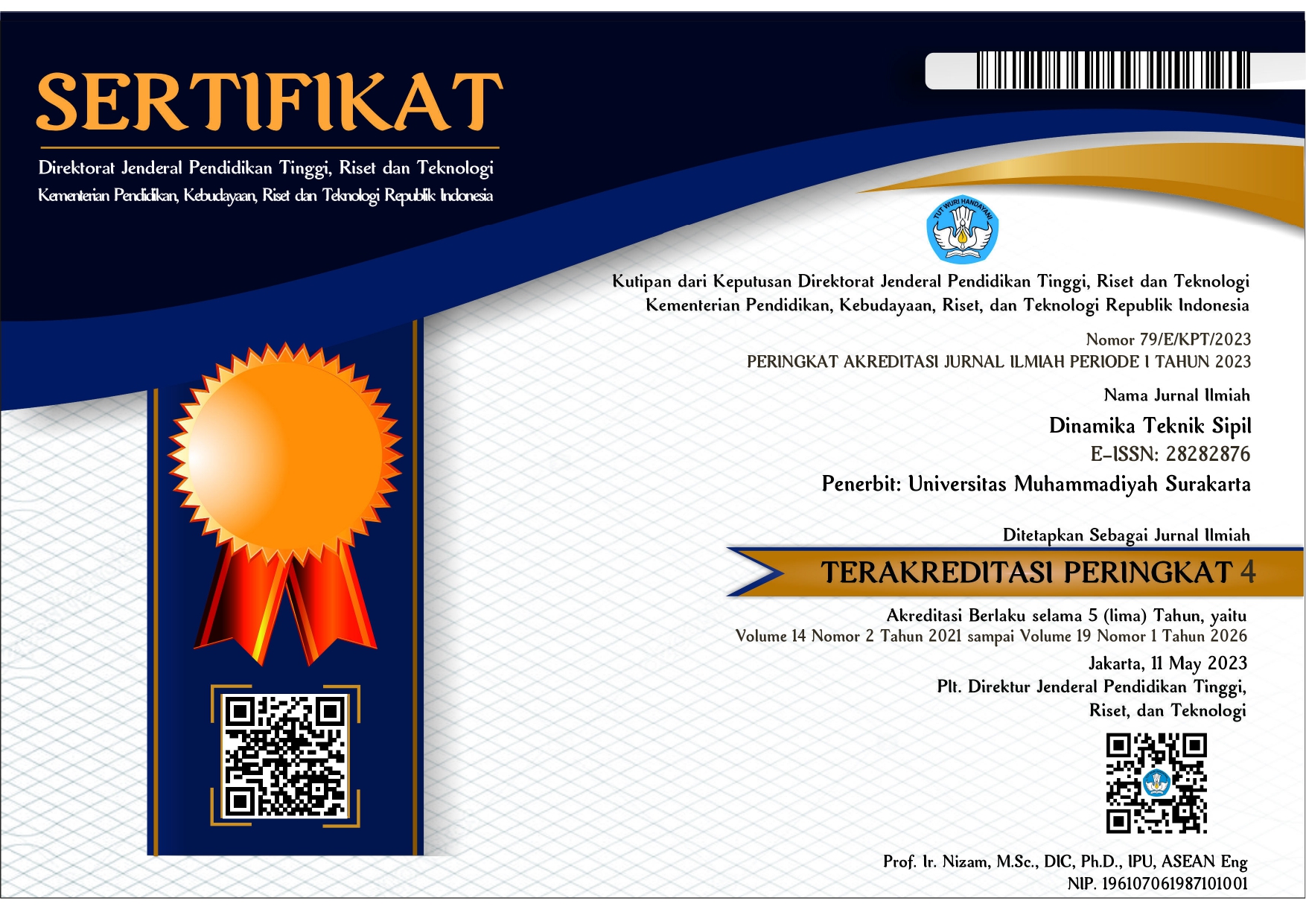Drought Analysis Using Various Drought Indices in Sub-District Ngemplak
DOI:
https://doi.org/10.23917/dts.v17i2.6134Keywords:
agricultural productivity, drought analysis, drought indices, water management strategiesAbstract
The study namely Drought Analysis Using Various Drought Indices in District Ngemplak, Boyolali offers a comprehensive examination of drought phenomena in the Ngemplak, Boyolali district through the lens of various drought indices, aiming to understand the impact on agricultural productivity and propose effective water management strategies. Using data from 2009 to 2023, this study used SPI and PDSI. Focusing on the Ngemplak, Boyolali district, this research identifies the most relevant drought indices tailored to the local climatic and geographical contexts, analyzes the correlation between these indices and the productivity of primary crops, and suggests sustainable water management practices to mitigate drought risks. The study underscores the importance of adopting a multifaceted and adaptive water management framework, incorporating sophisticated irrigation technologies, and fostering policy reforms to enhance water use efficiency and resilience against climatic variability. It calls for collaborative efforts involving stakeholders across different sectors to implement these recommendations, ensuring the sustainability of water resources and agricultural productivity in the face of drought challenges.
Downloads
References
Adhyani, N.L., June, T., Sopaheluwakan, A. 2017a. Exposure to Drought: Duration, Severity and Intensity (Java, Bali and Nusa Tenggara), in: IOP Conference Series: Earth and Environmental Science. Institute of Physics Publishing. https://doi.org/10.1088/1755-1315/58/1/012040
Adhyani, N.L., June, T., Sopaheluwakan, A. 2017b. Exposure to Drought: Duration, Severity and Intensity (Java, Bali and Nusa Tenggara), in: IOP Conference Series: Earth and Environmental Science. Institute of Physics Publishing.
Adnan, S., Ullah, K., Shuanglin, L., Gao, S., Khan, A.H., Mahmood, R. 2018. Comparison of Various Drought Indices to Monitor Drought Status in Pakistan. Clim. Dyn. 51, 1885–1899. https://doi.org/10.1007/s00382-017-3987-0
Arnone, E., Cucchi, M., Gesso, S.D., Petitta, M., Calmanti, S. 2020. Droughts Prediction: a Methodology Based on Climate Seasonal Forecasts. Water Resour. Manag. 34, 4313–4328. https://doi.org/10.1007/s11269-020-02623-3
Asdak, Chay. 1995. Hidrologi Dan Pengel-olaan Daerah Aliran Sungai (Cetakan Kelima). Gadjah Mada University Press.Yogyakarta.
Arra, A.A. & Şişman, E. 2024. Innovative Drought Classification Matrix and Acceptable Time Period for Temporal Drought Evaluation. Water Resources Management 2024 38:2811–2833. https://doi.org/10.1007/s11269-024-03793-0
Avia, L.Q., Yulihastin, E., Izzaturrahim, M.H., Muharsyah, R., Satyawardhana, H., So¬fiati, I., Nurfindarti, E., Gammamerdianti. 2023. The Spatial Distribution of a Compre¬hensive Drought Risk Index in Java, Indo¬nesia. Kuwait Journal of Science.
Cheval, S., 2015. The Standardized Precipitation Index–an Overview. Rom. J. Meteorol, 12(1-2), pp.17-64.
Chidiac, S., El Najjar, P., Ouaini, N., El Rayess, Y., El Azzi, D. 2023. A Comprehensive Re¬view of Water Quality Indices (WQIS): His¬tory, Models, Attempts and Perspectives. Rev Environ Sci Biotechnol 22, 349–395.
Jin, C., Jiang, N.., Tian, X., Zheng, E. & Shi, Q. (2024). Analysis of the Spatial and Temporal Evolution of Drought in Henan Based on A Nonlinear Composite Drought Index. Scientific Report, www.nature.com/scientificreports. https://doi.org/10.1038/s41598-024-80641-6
Keyantash, J. and Dracup, J.A., 2002. The Quantification of Drought: An Evaluation of Drought Indices. Bulletin of the American Meteorological Society, 83(8), pp.1167-1180.
Korkmaz, M, & Alban Kuriqi, A. 2024. Regional Climate Change and Drought Dynamics in Tunceli, Turkey: Insights from Drought Indices. Water Conservation Science and Engineering (2024) 9:49. https://doi.org/10.1007/s41101-024-00281-9
Morsidi, A. 2017. Management of Disaster Drought in Indonesia, Jurnal Terapan Manajemen dan Bisnis.
Nikmatillah, V.M., Anggraeni, D., Hadi, A.F. 2018. Drought Analysis Using Various Drought Indices in Dis¬trict Boyolali, in: SCITEPRESS—Science and Technology Publications.
Pudyastuti, P.S. & Musthofa, R. A. 2020. Analisa Distribusi Curah Hujan Harian Maksimum di Stasiun Pengukur Hujan Terpilih di Wilayah Klaten Periode 2008 – 2018. Dinamika Teknik Sipil Majalah Ilmiah Teknik Sipil. https://journals.ums.ac.id/DTS/article/view/11589/5795
Sarang, Y., Devlekar, S., Yeole, A. 2023. Pre-dicting and classifying water quality, treat¬ment, and usage: a comprehensive review. International Journal of Information Tech¬nology 15, 2837–2845. https://doi.org/10.1007/s41870-023-01285-9
Tabari, H., Hosseinzadeh Talaee, P. 2013. Mois¬ture index for Iran: Spatial and tem-poral analyses. Glob Planet Change 100, 11–19. https://doi.org/10.1016/j.glopla-cha.2012.08.010
Triatmodjo, Bambang. 2008. Hidrologi Tera-pan. Yogyakarta: Beta Offset.
Wilhite, D.A. 2000. Chapter 1 Drought as a Natural Hazard: Concepts and Definitions.
Yu, H., Zhang, Q., Xu, C.Y., Du, J., Sun, P., Hu, P. 2019. Modified Palmer Drought Severity Index: Model improvement and appli¬cation. Environ Int 130. https://doi.org/10.1016/j.en-vint.2019.104951
Downloads
Submitted
Accepted
Published
Issue
Section
License
Copyright (c) 2024 Agus Budi Mulya, Purwanti Sri Pudyastuti, Isnugroho Isnugroho, Hermono Budinetro

This work is licensed under a Creative Commons Attribution-NonCommercial 4.0 International License.









